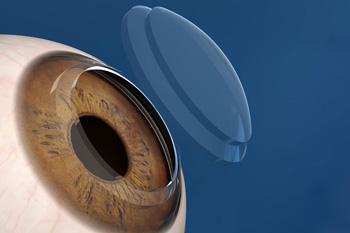
A new technique at the Vanderbilt Eye Institute uses unique incision patterns to help speed recovery and improve vision for cornea transplant patients.
Laser’s role growing in cornea transplants
Vanderbilt Eye Institute's Laser Sight Center is the only facility in the region using new technology that may alter the way cornea transplants are done.
Uyen Tran, M.D., a corneal specialist at VEI, will begin using the IntraLase femtosecond laser in the fall. Widely used in a procedure known as “bladeless LASIK,” the laser is not new to the world of visual sciences, having been used in LASIK procedures for more than a decade. But its adaptation for use in transplantation is novel.
“The application of this laser, that is so well known in LASIK, for medical purposes is absolutely fantastic,” said Tran. “This is an advancement that will revolutionize corneal transplantation.”
Tran performs about 200 cornea transplants a year. Traditional transplantation uses a surgical blade that cuts straight, vertical edges in the cornea to a predetermined size. The surgeon then uses another blade to remove the patient's cornea. The donor cornea would be sewn in place with numerous sutures.
“With traditional transplantation the standard wound never seals down completely,” said Tran. “Even 10 years down the road, the incision can rupture after minor trauma.
“With this new cutting technology, both the donor and recipient cornea are cut in a precise, unique pattern that will then fit together like a lock and key.”
The infrared laser allows for better control and faster healing and visual recovery. Each pulse of the laser takes one quadrillionth of a second. It allows the surgeon to direct the energy deep into the cornea, only treating the affected tissue with no collateral damage to the surrounding area. This process is called photodisruption.
Because of the speed and precision of the femtosecond laser, this portion of the surgery only takes minutes.
The final transplant will require fewer sutures, resulting in much less astigmatism and much more rapid visual recovery. With the traditional method, some patients required hard contact lenses after surgery to correct their vision.
“When you have a beautifully clear transplant and yet the patient still can not focus because of high astigmatism, that's a surgical success, but a visual failure,” said Tran. “This is a huge advancement for many of our patients, especially the elderly who cannot wear hard contact lenses due to arthritis and Parkinson's.”
Tran said the outpatient procedure can restore sight to a large population of patients who have corneal scarring due to infectious ulcers, congenital defects and trauma. Patients with autoimmune disorders that attack the eye, including Lupus, arthritis and stem cell patients suffering from graft versus host disease, are also helped.
Another key feature of the laser is its ability to make partial thickness custom cuts that are not permanent until the surgeon finishes the cut in the operating room. The patient undergoes the laser procedure in the LASIK suite and the cut will remain stable until the time of the surgery in the O.R.
“The beauty of the laser is that I make the cut, but it is not complete until I dissect it by hand,” Tran said. “If I never remove the cornea by dissecting it out, it will seal back as if it was never touched. We never had that option with traditional corneal procedures.”
“The cornea is the window to the eye.“It has to be optically clear in order for us to have good vision. This new technology is a huge step forward in the rehabilitation of vision for a great number of patients,” Tran said.













